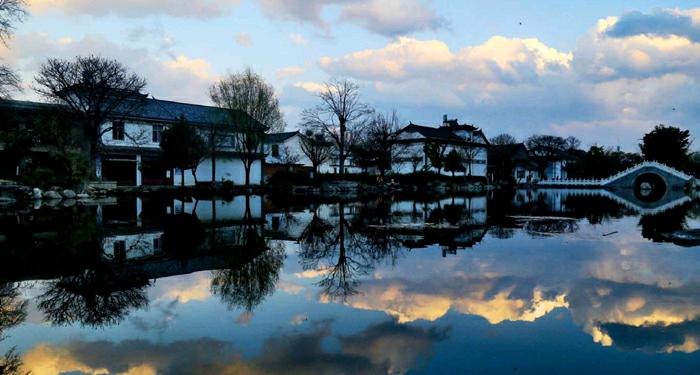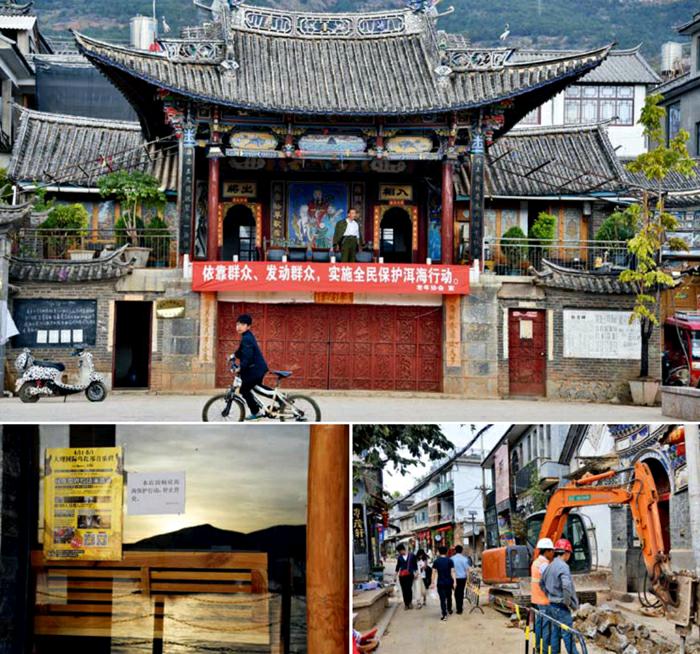Erhai Lake: Protection Mode
by+Yin+Xing
This April Fools Day, no one was joking around in the Erhai Lake preservation district.
On April 1, 2017, visitor Xingxing Diandeng had to reschedule a planned three-day trip to Dali, Yunnan Province during the Qingming Festival holiday when he noticed his hotel reservation payment had been refunded. What happened?
On March 31, 2017, the municipal government of Dali shut down all restaurants and inns within the core area of the ecopreservation district around Erhai Lake until a nearby sewage interception project is completed. The core area is densely populated with over 1,800 restaurants and inns that offer enchanting lake views to visitors. The project shut down every single one of the popular “lake-view houses.”
Growing Pains
Dali has long been famed for its snowcapped mountains and the tender moonlight on Erhai Lake. Every year, it draws steady streams of visitors from home and abroad. In recent years, however, Dalis tourism capacity has been overwhelmed due to the development and construction of the town of Haidong. Shuanglang, a small town of Bai people by the lake, received 2 million visits in 2014. In 2016, the volume exceeded 3.2 million. Within the onesquare-kilometer area at the core of the towns tourist zone, there are more than 580 restaurants and inns.
Heavier pollution has accompanied the increase in visitors. Despite Shuanglangs focus on agriculture over industry, the area around Erhai Lake has been listed for poor water quality due to subpar treatment of sewage from the inns before it is dumped directly into the lake.
Tourism has also impacted neighboring islands such as Jinsuo (Golden Shuttle). For generations, the local fishermen inhabiting Jinsuo Island have survived by fishing, but now more and more locals are turning to tourism, selling souvenirs, running restaurants and inns or serving as tour guides.
The heavy flow of tourists—more than 2,000 daily—has resulted in plentiful concerns. “Drinking water tops the list,” stresses villager Yang Xu. As the water quality in Erhai Lake deteriorates, local access to clean drinking water is lost, and they are forced to explore other methods to get water, such as filtering it from karst caves. “Aquatic food is most popular with tourists,” Yang adds. “Just a couple of years ago, during fishing season in April, we could catch up to 5,000 kilograms of fish a month. Now, however, the population of snail and shellfish has shrunk due to the deteriorating water quality of the lake. Many fishermen now go elsewhere to buy fish.”
And to provide better views, the inns have become taller, some eclipsing the limits set by the government. To increase their space, many inns began occupying public roads. Some even extended decks over the lake.
Overloaded Ecosystem
Erhai Lake is precisely what attracts tourists, but its also the prime source of drinking water for Dali residents. As estimated by the local environmental protection department, the population bearing capacity of the area around the lake is 200,000 to 500,000 at the most. Today, however, some 860,000 people live around it, excluding the temporary population. The lake welcomes 10 million visits annually, far beyond the carrying capacity of the local environment.
The tourism boom has also highlighted the irrational layout of villages and townships along the coastline, including Shuang- lang and Haidong, as well as the flaws in the underdeveloped infrastructure.
“Pollution discharge pipes were designed to serve only permanent local residents,” notes an engineer. “The old system in the Haidong area can barely handle the heavy flow of sewage today, and household waste volume far exceeds the intended capacity.” The dense construction of inns and rapid increase in tourist flow have led to a steep rise in discharge, some of which is dumped directly into the lake or seeps up from the ground due to the narrow, aging pipes.
According to the 13th Five-Year Plan for Environmental Protection of Erhai Lake, in 2014, pollution from ranching, farming and rural life accounted for about 70 percent of the total pollution in the region. Zhang Bo, director of the Department of Water Environment Management of the Ministry of Environmental Protection, spoke at a recent press conference on the issue. “Many visitors from outside Erhai live, eat and consume there, which has expanded the scale of other agricultural sectors,” he explained. “These sectors still need to consume and discharge. Every place like this needs to keep a close eye on its environmental carrying capacity.”
Renovation Needed
Despite being a top vacation destination, Erhai has temporarily shut down all of the 1,800-plus inns and restaurants in its core area, demonstrating the incredible resolve of the local government to hone environmental protection.
Comprehensive regulations to protect the environment of Erhai will be introduced, including measures to treat sewage and trash, decrease non-point source pollution, restore water quality, accelerate projects to intercept and treat sewage, strengthen law enforcement, supervise activities in the lake region, and encourage everyone to protect Erhai Lake.
“The sewage interception project at Erhai Lake, funded by an investment of over 1.3 billion yuan, is now under construction,” explains Zhang Yong, deputy secretary of the Dali Municipal CPC Committee. “The project will benefit 10 towns and villages by the lake by improving sewage treatment capacity.” The total population of inns and restaurants in the core area of the lake will be strictly controlled, and only environmentally-friendly structures and public infrastructural facilities will be allowed to be built.
Dali is even setting up a monitoring network for the lake. The Erhai Region Protection Administration is inviting bids for a project to provide early warning monitoring at Erhai, including fluvial cross sections, a water quality monitoring system and analysis of major pollution sources.
These moves are focused primarily on the inns, followed by other sources of pollution such as agriculture. More than 20,000 digestion tanks will be built to deal with the problems. In the township of Wase, 11 public officials made deals in 15 days to acquire land from more than 200 farming households to create nearly 30 hectares of land for these projects.
Renovation work, however, is a challenge. “The situation is still precarious, despite the successes we have had,” remarks a supervisor from the local environmental protection department. “The water volume is still insufficient, and the harnessing system has yet to be perfected.”
“The measures we are taking are necessary even though we wont see the effects instantly,” asserts Wang Xinze, vice president of Yunnan (Dali) Research Institute under Shanghai Jiaotong University. “It would take a while to restore what has been lost even if we replaced all the polluted water in the lake with bottled water.”

